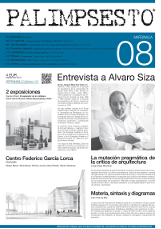Architecture and Structures. A classic exemple: Ville Savoie
DOI:
https://doi.org/10.5821/pl.v0i8.2748Abstract
This article offers a reflection about the intimate relation between architecture and its supporting structure. The transfer of the structural weight and live loads is relevant for every building and therefore appears as an intrinsic part of the essence of architecture. Bearing walls allowed this load transmission until the mid-19th century. Untying walls from their traditional function through the incorporation of independent structural systems was one of the most important shifts taking place at the beginning of the 20th century.
Le Corbusier’s Ville Savoye, in the 1930s, became a perfect example of these new values. The structural analysis of this masterpiece shows that one of the pillars on the second floor does not continue vertically to the ground. Instead, the supporting element disappears on the ground floor and the loads are transferred through two additional pillars placed symmetrically. This operation does not affect the value of a project that opened the door to so many new concepts in architecture.
Downloads
Issue
Section
License
PROTECTION AND INTELLECTUAL PROPERTY CRITERIA
Authors whose work is published in en Palimpsesto agree to the following terms:
1. The author retains the copyrights and guarantees the magazine the right to apply a Creative Commons Attribution-NonCommercial-NoDerivatives (CC BY-NC-ND), which permits others to share the work with acknowledgement of authorship.
2. The author may establish additional agreements of his or her own accord for non-exclusive distribution of the article published in the magazine (for example, in an institutional repository, or published in a book).
3. Electronic distribution of the work by the author(s) is permitted and encouraged (for example, in institutional repositories or on the author’s own website), prior to, and during the submission process, as this can generate productive exchanges, as well as earlier and greater citation of the published works (see The Effect of Open Access) (in English).
4. The author or provider of the material submitted for publication authorizes Palimpsesto to publish, with no obligation whatsoever (financial or otherwise) to the content of said material, be it in paper or digital format, or in any other medium.
5. The author or provider guarantees that he or she is the owner of the Intellectual Property rights to the contents provided, which encompasses the text and images/photographs/photographic works incorporated in the article.
6. The author or provider, exempts Palimpsesto magazine of all and any responsibility relating to violation of copyrights, thereby committing himself or herself to undertaking all efforts to assist Palimpsesto magazine in defence of any accusation, extra-judiciary, and/or judicial measures. Likewise, the author or provider will assume payment to Palimpsesto of any sum or compensation that must be paid to third parties for failure to comply with these obligations, be it the result of judicial, arbitrary or administrative decisions.
7. The submission of the texts by authors implies automatically a declaration of non plagiarism of its contents







